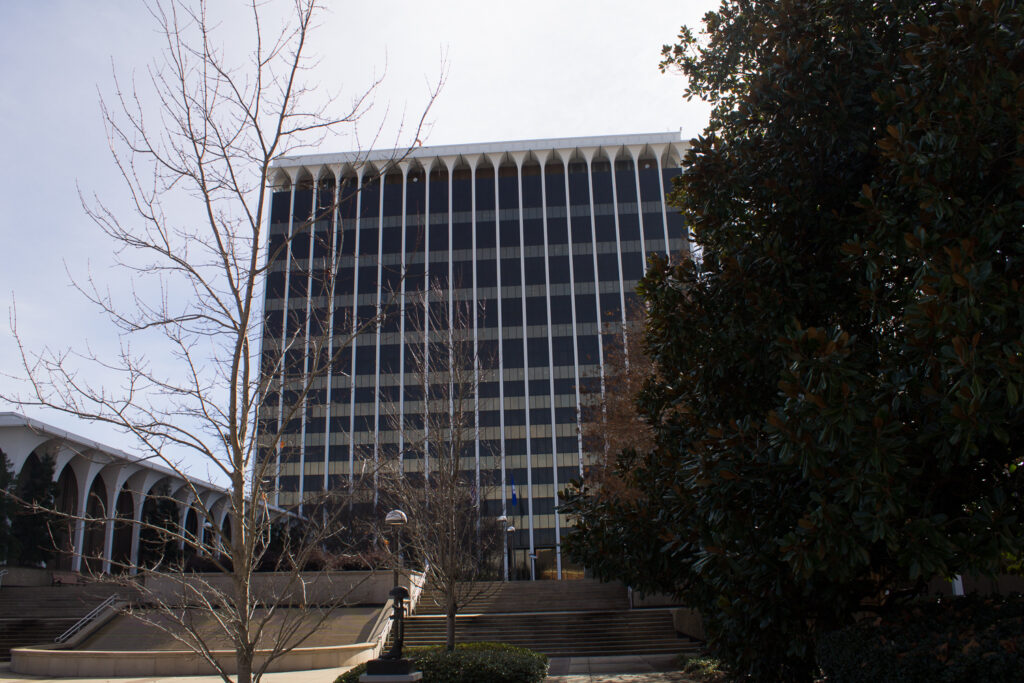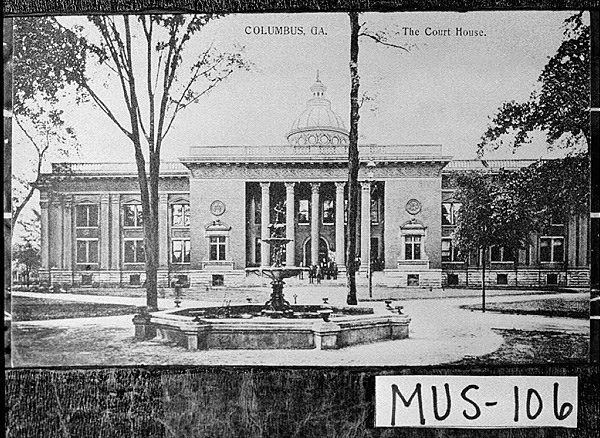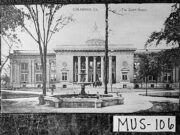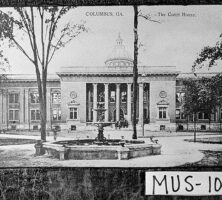Muscogee County, located in west central Georgia, was established by the state legislature on June 9, 1825, along with Carroll, Coweta, Lee, and Troup counties (though the counties were not officially named until December 1826). Located on the Chattahoochee River and adjacent to the Alabama state line, the county is home to Columbus, the third largest city in the state.
Muscogee County and the city of Columbus formed the first consolidated government in Georgia in 1971. Located on the fall line between the Piedmont and the Coastal Plain, the county’s location has been crucial to its development as a center of trade and industry. The population in 2010 was 189,885, an increase from the 2000 population of 186,291.
The original residents of the area were Native American, from which the name Muscogee is derived. In 1825 the Creek Indians ceded a large area between the Flint and Chattahoochee rivers in the Treaty of Indian Springs. Out of this land the state of Georgia founded several new counties, including Muscogee, with a total land area of some 2,000 square miles. Beginning in 1827, the size of the county was reduced when Harris, Marion, and Talbot counties were formed from the northern and eastern portions of the original Muscogee County. In 1854 an additional county, Chattahoochee, was formed from the southern section of Muscogee County. Other counties that contain land from the original Muscogee County include Macon, Schley, and Taylor. Today the county comprises 216 square miles.

Although there were already white settlers in the area, the Georgia General Assembly was concerned with the development of the area along the fall line of the Chattahoochee River. In December 1827 the state called for the establishment of a trading town near Coweta Falls on the Chattahoochee. Named Columbus, the new town also served as the county seat of Muscogee County. In early 1828 the exact site for the new town was chosen, lots were laid out, and in July the lots were offered for public sale. Included in the town plan were two lots for use by the county.
In the period leading up to the Civil War (1861-65), Columbus developed rapidly into a regional trading center. The cotton trade spurred this development, as steamboats loaded with cotton began departing the city even before the initial survey of the area was complete. The first railroad reached the city on December 31, 1851, and by the time of the Civil War both railroad and river traffic serviced the city regularly. Industry developed along the river as well, as manufacturers utilized the power generated from the falls of the Chattahoochee. By 1860 Muscogee County contained three grist mills, several textile mills, and a number of smaller manufacturing operations. In all, 16,584 people lived in the county in 1860, making Muscogee the fourth most populous county in the state.
During the Civil War the manufacturing interests in Columbus produced a variety of wartime goods, including swords, cannons, ironclad ships, paper, and clothing. One of the last military actions of the Civil War took place at Columbus on April 16, 1865, when Union forces under Major General James H. Wilson captured the city and subsequently destroyed many of the city’s industries, including the textile mill, sword factory, and paper mill.
During the late nineteenth and early twentieth centuries, Columbus gradually recovered from the devastation of the war, producing a variety of such products as clothing, industrial machinery, and soft drinks. Since 1960 insurance, banking, and digital technology firms have taken the lead role in the local economy. Columbus and Muscogee County are home to American Family Life Assurance Corporation (Aflac) and Synovus financial group, whose subsidiary, Total Systems Services, Inc., is one of the largest data processing and support systems in the world.

Also located partially in Muscogee County is Fort Moore, named for Lieutenant General Harold “Hal” Moore and his wife, Julia Moore. The fort was previously named after Confederate general and Columbus resident Henry L. Benning but became subject to revision in 2023 when a 2021 act of Congress enforced changes to Department of Defense assets associated with the Confederacy. Established in 1918, Fort Benning at first occupied a small site on Macon Road in Columbus, but federal officials acquired the 1,800-acre Riverside Plantation and 115,000 adjoining acres to create a training school for army infantry. Although the majority of the base is in adjoining Chattahoochee County, it is a major contributor to Muscogee’s economy as well.
Muscogee County has a vibrant cultural heritage and has served as home to a number of notable artists, musicians, and writers. Alma Thomas, a native of Columbus, was a well-known twentieth-century painter. Thomas “Blind Tom” Wiggins, a blind African American piano prodigy, was born into enslaved status in Harris County and raised in Muscogee; he later became a noted composer and concert performer. Gertrude “Ma” Rainey , known as the “Mother of the Blues,” also made her home in Columbus. Both performers were among many to take the stage of the Springer Opera House in Columbus, which opened in 1871 and after extensive restoration was named the State Theatre of Georgia in 1971.
Muscogee County claims a number of notable authors as well. Augusta Jane Evans Wilson, who lived most of her adult life in Mobile, Alabama, was born in Muscogee County in 1835. Evans modeled her 1866 novel St. Elmo on the plantation El Dorado, which was renamed St. Elmo in recognition of the novel’s success. Carson McCullers, whose works often portray the mill town of Columbus where she grew to adulthood, is perhaps best known for her 1940 work The Heart Is a Lonely Hunter. Today visitors can tour her Stark Avenue home, which houses the Carson McCullers Center for Writers and Musicians.
Opportunities for higher education are available in the county at Columbus State University and Columbus Technical College.







